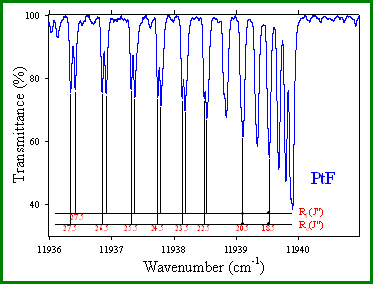Reports: B6
43751-B6 Spectroscopy of Gas Phase Palladium- and Platinum-Containing Radicals
Research this year has focused
on the spectroscopy of several platinum compounds, most notably PtF. This
is the first spectral observation of PtF.
 Figure 1. A strong electronic transition of PtF was
observed with an origin at 11940 cm-1; it is identified as a
vibrational band of a new [11.9] 2Π3/2
X 2Π3/2
Figure 1. A strong electronic transition of PtF was
observed with an origin at 11940 cm-1; it is identified as a
vibrational band of a new [11.9] 2Π3/2
X 2Π3/2
We have recorded the Doppler-limited spectrum of gas phase PtF resolution in the 11400 cm-1 13000 cm-1. The spectra are recorded using intracavity laser absorption spectroscopy (ILS) located at UM-St. Louis in the laboratory of our collaborator, Prof. James O'Brien. A portion of this spectrum is given in electronic transition. The vibrational numbering of this band is tentatively assigned as the (0,0) band, based on its strong intensity and very small isotopologue structure. Even at J~37.5 Pt isotopologue structure is not observed. The band at 11940 cm‑1 is now completely analyzed. A second electronic transition of PtF has been observed at 12523 cm-1, and the analysis is in progress. This second band may be a transition to a new excited electronic state or the (1,0) band of the [11.9] 2Π3/2 X 2Π3/2 electronic transition.
Work has continued on other projects such as PtC, PtO, and PtN. The newly observed spectrum of PtN, with a bandhead at 11737 cm-1, has now been analyzed and is identified as a 2Σ- - X 2Π1/2 transition. The PtN spectrum shows clear isotopologue structure (194Pt, 195Pt, and 196Pt) as well as large hyperfine structure from the 195Pt isotope (I= ½). This work is in its final stages and should be submitted for publication during Spring 2010.
The ACS-PRF award supports our research and positively impacts our careers by providing funding for research supplies, travel for conferences, and salary for summer work. Platinum intermediates are important in many catalytic reactions, and this research provides insight into the electronic structure and bonding of Pt-ligand fragments.




